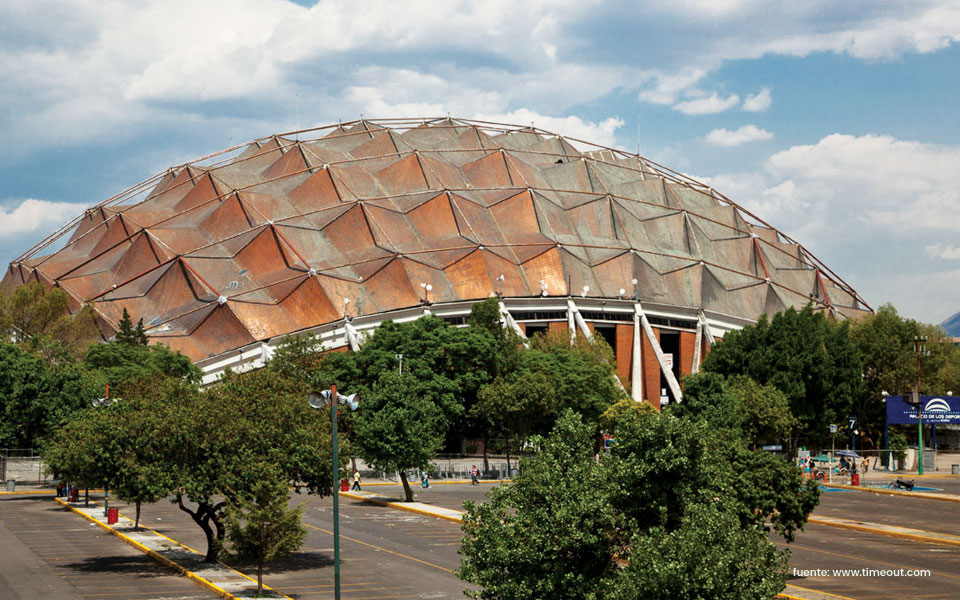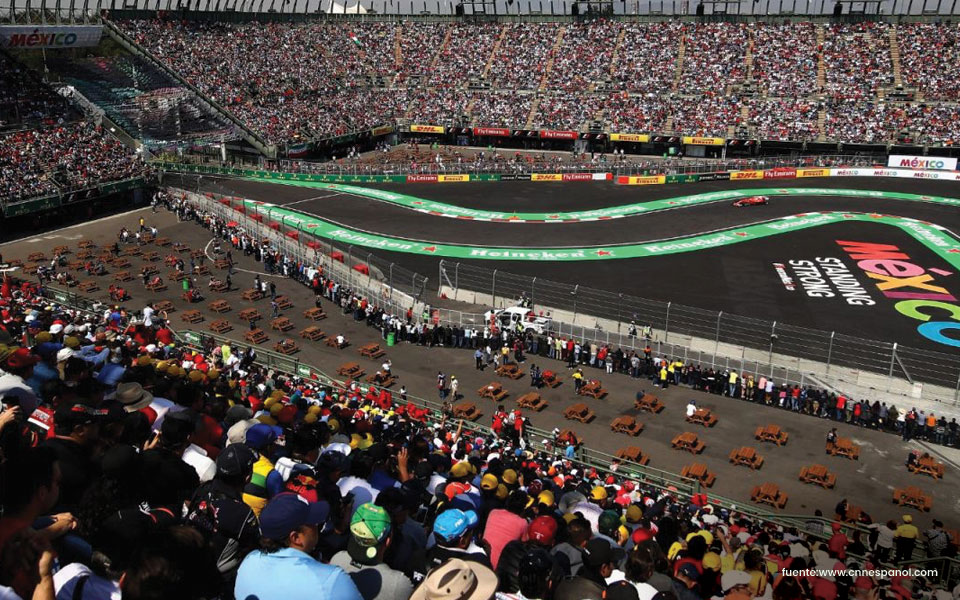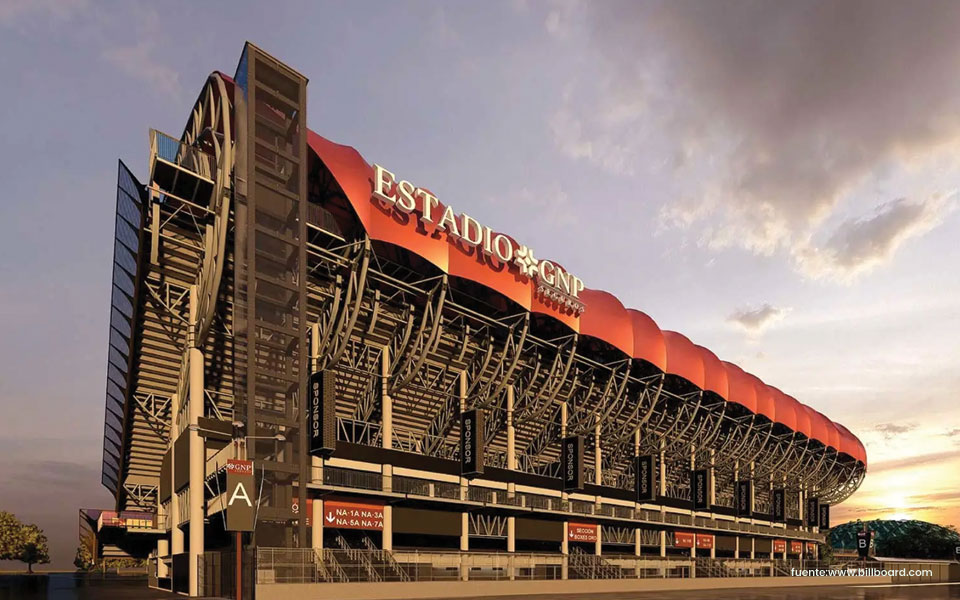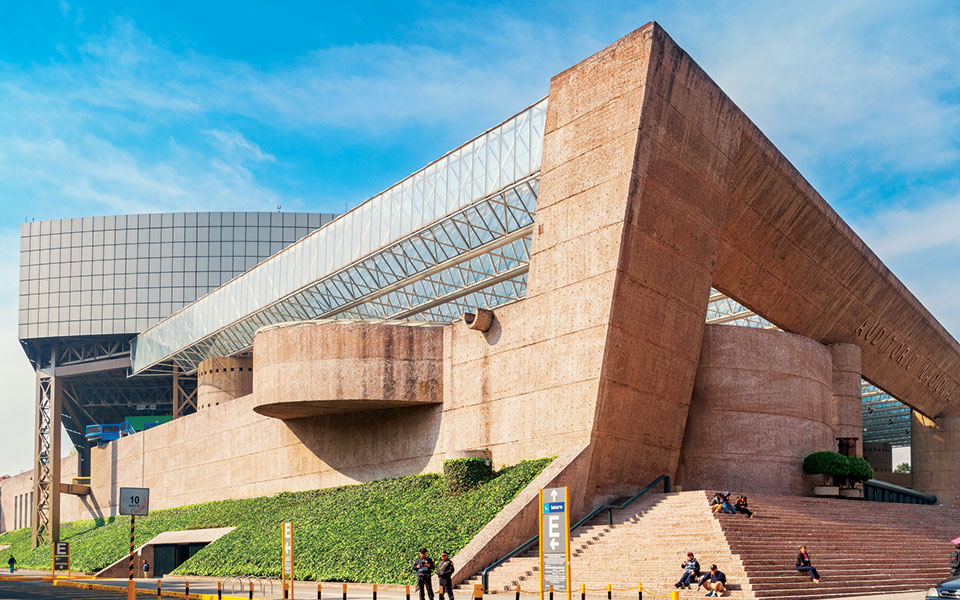

 Estimated reading time:
11 min.
Estimated reading time:
11 min.
 Published on:
September 30, 2025 | 10:11am
Published on:
September 30, 2025 | 10:11am
Mexico City is a vibrant, passionate metropolis, and it has become home to some of the most impressive and well-known entertainment venues in Latin America.
From massive concerts and sporting events to cultural festivals and theatrical productions, these facilities have offered unforgettable experiences for both residents and those who are just passing through.
For this reason, today we would like to tell you about Mexico City’s most iconic event spaces. Get ready for a fascinating tour through the settings that have seen spectacular shows and continue to be the heart of entertainment in Mexico’s capital city.
Inaugurated October 8, 1968, Palacio de los Deportes arena is an architectural gem designed by Spanish architects Félix Candela, Enrique Castañeda Tamborel, and Antonio Peyrí.
The venue was built in a record 18 months for the 1968 Olympic Games, during which it played host to the event’s basketball games.
This stadium’s distinctive dome was designed using parabolic and hyperbolic geometry and fabricated from copper. It has earned the arena the nickname, “Copper Dome” or “Palace of a Thousand Suns” for the way it constantly reflects sunlight.

The sports arena has hosted a wide variety of events, from sports competitions to world-class concerts.
It has welcomed artists such as Paul McCartney, Cirque du Soleil, Madonna, Ed Sheeran, Roger Waters, Sam Smith, The Rolling Stones, and more. Top sports events have also been held here, such as NBA games and tennis tournaments.
The venue can hold around 18,000 people, making it one of the city’s most versatile spaces.
The arena sits at the intersection of Río Churubusco Avenue and Añil Avenue in Granjas México, Iztacalco. You can get there on public transportation (Metro train stations Velódromo and Oceanía are nearby) and private transportation.
Autódromo Hermanos Rodríguez is one of most outstanding racetracks in Mexico and around the world. The track was designed by the engineer Óscar Fernández Gómez in 1955 as part of his thesis project, since the city did not have an official racetrack.
Ever since it was opened in 1959, it has been owned by the Mexican government. In time, it was named in honor of the brothers Pedro and Ricardo Rodríguez, prominent Mexican racing drivers in the 1960s.
Meanwhile, the track has been remodeled several times to keep up with international standards and continue being a pacesetter in motor racing. It is so well known that it is recognized as the fastest circuit in the F1, as Brazilian driver Felipe Massa set a record of 226.2 miles per hour in 2015 during the Mexican Gran Prix.
Thanks to its unique characteristics, the racetrack has become famous for hosting Formula 1’s Mexican Gran Prix, an event that pulls in thousands of racing fans every year. It also holds Champ Car, NASCAR, and motorcycle races.
Furthermore, it has been one of the best places to hold concerts in Mexico. Famous artists such as Demi Lovato, Camila Cabello, Garbage, Evanescence, Green Day, Shawn Mendes, Paul McCartney, and many others have performed here. This thrilling open-air space makes for the ultimate experience.

The racetrack’s capacity varies according to the event, but it can hold up to 110,000 spectators during the Mexican Gran Prix. This makes it one of the most expansive venues for holding massive events in Mexico City in 2024.
The racetrack is found in Ciudad Deportiva de Magdalena Mixhuca sports complex, in Iztacalco, very close to the airport, Aeropuerto Internacional de la Ciudad de México. This makes getting there and away easier for national and international visitors.
Unfortunately, it does not offer parking, so the easiest way to go is by Metro train on line 9. You can get off at stops near the gates, such as the Ciudad Deportiva, Puebla, and Velódromo stops.
Another option is taking line 2 of the Metrobús transit system to UPIICSA or Iztacalco stops, provided you know that you want to enter from Añil Avenue.
Foro Sol stadium was inaugurated in 1993, at a time when the country lacked adequate facilities for staging large-scale events and concerts in Mexico City. The architect, José de Arimatea Moyao López, came up with the idea of installing four enormous grandstands in the Autódromo Hermanos Rodríguez racetrack, a facility that at that point was not being used.
The site chosen for the stadium seats was the racetrack’s banked curve, where just one year before the last F1 Mexican Gran Prix race had been held.
Nonetheless, thanks to successful shows by the likes of Madonna, Paul McCartney, Pink Floyd, and the Rolling Stones, in 1997 it was decided to build a more permanent facility, now called Estadio GNP. The stadium is easily recognizable for its green steel structure. GNP insurance company purchased naming rights, leading to the new moniker.
Over its 23 years, the stadium has been remodeled at various times, with significant changes made for the CART races in 2002, when the track was adapted so car races and baseball events could still be held, but the racetrack kept its distinctive layout.
This venue has seen memorable performances by legendary musicians and bands such as those mentioned above, plus U2, Metallica, Coldplay, and David Bowie. The multipurpose stadium is also the home to major festivals such as Vive Latino and Corona capital, which bring together thousands of attendees every year.
Likewise, it is possible to enjoy an endless array of sporting, religious, and cultural events, or even the over-the-top Monster Trucks and Motocross shows.
Estadio GNP can accommodate up to 65,000 people for concerts, making it one of the city’s largest venues for live music and other huge shows.
Its design allows for excellent visibility and acoustics from almost any spot in the stadium, creating an unbeatable experience for those who are lucky enough to go.

Sitting inside the sports complex known as Ciudad Deportiva Magdalena Mixhuca, in Iztacalco, Estadio GNP is well connected to many public transportation routes, including Metro trains and the Metrobús system.
Plus, its proximity to other important sporting and cultural facilities puts it at the heart of Mexico City’s entertainment scene.
Opened on February 25, 2012, Arena Ciudad de México is one of the capital’s most modern music venues.
Built by the company Grupo Avalanz, the entertainment arena shines for its cutting-edge design and state-of-the-art facilities. A few of its features include 2 heliports, more than 100 luxury suites, some 800 LCD screens, and ample parking space for at least 5,000 vehicles. This is the gold standard in entertainment infrastructure.
Since its opening, Arena Ciudad de México has been a sensational stage for world-class artists like Roger Waters, Bruno Mars, Katy Perry, Michael Bublé, and Aerosmith.
Furthermore, it has become the site for some sporting events such as NBA games and WWE wrestling matches. There have even been family shows like Disney on Ice and conferences.
The arena can seat a maximum of 23,000 people, making it versatile enough to accommodate a wide range of events, from intimate concerts to large-scale shows and sporting events.
Arena Ciudad de México stands at 800 de las Granjas Avenue, in Santa Bárbara, Azcapotzalco. Its location on the north side of the city can be reached by a number of public transportation routes, including Metro trains and the Metrobús system.
In 1948, after the extraordinary performance of the national equestrian team in the London Olympic Games, then-President Miguel Alemán decided to dedicate land near Campo Marte, a military and government facility, to encourage equestrianism in Mexico.
In the beginning, the project was called the municipal auditorium and was carried out under the leadership of the architects Fernando Parra Hernández, Fernando Beltrán Puga, Fernando Peña Castellanos, and Óscar de Buen. It included stables, quarters for stable hands, a granary, and a main theater.
Later, in 1955, it was renamed the national auditorium. However, after renovations undertaken in 1990 by architects Teodoro González de León and Abraham Zabludovsky, this venue became one of the largest and most prestigious entertainment centers. It is also a key element of Mexico City’s emblematic architecture.
The Auditorio Nacional has welcomed a full array of musicians from a variety of genres, some, like Louis Armstrong, Duke Ellington, and the Great Russian Circus from Moscow, from the golden age to other stars including Plácido Domingo, Luciano Pavarotti, Alanis Morissette, Bon Jovi, even Luis Miguel, and Shakira.
The auditorium also hosts significant cultural events such as the UNAM’s (the national university) international film festival and the Festival International Cervantino cultural festival.
As far as how many people fit in Mexico City’s national auditorium, there is a space for 10,000 spectators over three levels.
Since it is one of the smaller auditoriums in Mexico City, it offers an intimate, up-close experience. So, it is ideal for concerts, plays, operas, and other prestigious cultural events.
This landmark stands at 50 Paseo de la Reforma Avenue, in Polanco. It is one of the city’s most iconic neighborhoods, filled with hotels, restaurants, and shops, making it is easily accessible by public transportation—Metro trains, Metrobús routes—and private options.

This enormous stadium is also known as the Colossus of Santa Úrsula, its neighborhood, and was opened on May 29, 1966. Ever since, the Azteca has been one of the world’s most emblematic sporting venues and a Mexican icon.
Designed by architects Pedro Ramírez Vázquez and Rafael Mijares Alcérreca, this stadium has seen historic moments in world football and other sports, as it was built to provide Mexico City with a top-of-the-line facility capable of hosting FIFA’s World Cup in 1970.
Estadio Azteca is especially famous for having been the site of two FIFA World Cup finals—the one in 1970, in which Brazil, led by Pelé, was crowned champion, and the 1986 Cup, when the Argentine team steered by Diego Maradona, won the trophy, establishing itself as the best in the world.
These events don’t only consolidate the stadium’s reputation as soccer’s holy ground but also make it a landmark for fans of the king of sports around the world.
Besides soccer, the colossus has opened its doors to other major sporting and cultural shows, such as some regular-season NFL games in 2005.
In addition to these accomplishments, the stadium is currently the home to the América soccer club and the Mexican national soccer team. It even had the honor of being selected for the 1968 Olympic Games.
This is without even mentioning that it has been the stage for incredible concerts with stars like Michael Jackson, Paul McCartney, U2, Elton John, Bad Bunny, and Shakira—giving their fans a magical moment to last their whole lives.
Furthermore, the stadium is awaiting the upcoming 2026 FIFA World Cup, when it will once again welcome the world’s best national teams and their fans with open arms for one of the most significant sporting events of all time.
Estadio Azteca can hold around 87,000 spectators, so it is one of Mexico City’s largest concert venues, capable of hosting monumental events.
Located in the south of Mexico City, at 3465 Calzada de Tlalpan Avenue, Santa Úrsula Coapa. There are several public transportation lines that reach the stadium, including the light rail and many bus routes.
Plus, it is very close to major streets and highways, so getting there by private car is no problem.
Undoubtedly, Mexico City is in a class of its own for taking the concept of entertainment to its highest level. From the magnificent Estadio Azteca stadium to the modern Arena Ciudad de México, these venues witness unforgettable experiences that have touched the lives of millions of people.
Come, attend one of these mind-blowing events and be part of entertainment history in vibrant Mexico City. See you there!